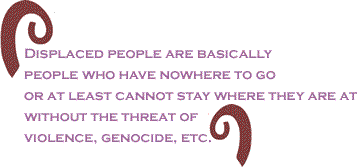
|
|||||||||||||||||||||
|
|
Since Hurricane Katrina, various political leaders, pundits and the general public have debated about how to describe Black people displaced by one of the greatest “natural disasters” ever to hit the US. In particular, there has been a great deal of tension regarding whether or not to describe Black people as “refugees.” Various African American political leaders and celebrities, including Jesse Jackson and Oprah Winfrey, have spoken out against the term refugee being applied to Black people, pointing out that African Americans are US citizens. This criticism and dismissal of the term refugee has raised a red flag among many “progressives,” some of whom are suggesting that African Americans are attempting to distance themselves from the third world where refugees are everywhere. Others have suggested that African Americans are getting more attention, sympathy and services from the Federal Government, the media and the public than other non-whites because they are not refugees or are refusing to accept such a label. Some are even suggesting that African Americans are being treated as “real Americans” whereas those groups with a history as refugees in the US are being “forgotten.”
I will not try to determine whether African Americans are refugees. But I do want to contribute to this debate by exploring the distinctions between being displaced and being granted refugee status. First and most important, there are distinctions between being displaced, being recognized as a refugee by different world organizations, and being granted refugee status in the US. Displaced people are basically people who have nowhere to go or at least cannot stay where they are at without the threat of violence, genocide, etc. Refugee status is a formal category. On many blogs, people have discussed how they looked up the definition of refugee in order to figure out their own thoughts regarding the current debate about its usage. The most obvious site to look up such a term is the United Nations website. So let us turn there. When you look up refugee on the UN website, you will be directed to the site for the United Nations High Commissioner for Refugees (UNHCR), which was established in 1950. In 1951, the UN convened a conference to discuss the status of refugees. That gathering produced a formal definition of refugee, which, according to the website of the UNHCR, is still the common definition employed today. As described by the 1951 convention, a refugee is someone who: “owing to a well-founded fear of being persecuted for reasons of race, religion, nationality, membership of a particular social group, or political opinion, is outside the country of his nationality, and is unable to or, owing to such fear, is unwilling to avail himself of the protection of that country...” Along with refugee, there are other various categories of displaced people used to assess the world refugee situation. The other category that concerns us here is Internally Displaced Persons (IDPs), who basically are displaced for the same reasons as refugees but have not crossed international borders and therefore will probably experience different legal and political responses to their situations. Distinctions Among the World’s Displaced Peoples It is important to note that refugees in the US do not usually come directly from their country of origin but rather will often come from a country in which they have been resettled. But the UNHCR does account for a refugee’s region of origin. This information can be helpful in assessing what national/racial groups are acquiring refugee status.
According to the UNHCR Statistical Yearbook, in 2003 there was a total number of 9,680,263 refugees around the world. The main origins of world refugees were the following: Afghanistan (2,136,000), Sudan (606,000), Burundi (532,000), Democratic Republic of the Congo (453,000), Occupied Palestinian Territory (428,000), Somalia (402,000), Iraq (369,000), Vietnam (363,000), Liberia (353,000), and Angola (330,000). By the end of 2003, 48% of the world refugees originated from the Asian region, 36% from the African region, and 11% from Europe. It is not entirely clear where exactly each refugees was placed but we do know that in 2003, 38% of all global refugees were hosted by Asia, 32% were hosted by Africa, 23% by Europe, and 6% by North America. Yet there is a distinction between being recognized as a refugee and as an Internally Displaced Person. In 2003, there were 4,186,759 people categorized as IDPs. Countries with some of the largest numbers of IDPs are Columbia (1,244,072), Azerbaijan (575,609), and Liberia (531,616). While there are certainly more refugees than IDPs recognized by the UN, the distinction is not insignificant considering that refugees often have access to some level of protection and forms of assistance to deal with their displacement not always or equally available to IDPs. Overall, then, we see that there are significant distinctions between the different categories employed to address the global situation and that not everyone who is displaced around the world is categorized as a refugee by the UN. While some debate the relevancy of the UN in really shaping world affairs, the UNHCR does play an extremely important function in determining who meets the requirements for refugee status, assisting many countries in this process. And as stated on the website of the Bureau of Citizenship and Immigration Services (BCIS), in order to be eligible for refugee status in the US, one must be referred by the UNHCR or be part of a group that the US Government considers at risk. In other words, resettlement in the US is usually a third effort at resettlement that is bureaucratically determined and more often than not involves the UNHCR. World Refugee Status v. US Refugee Status More central to the conversation about Hurricane Katrina’s survivors is the crucial difference between being a world refugee and being a US refugee. In short, being recognized as a refugee by the UNHCR is not the same as being given access to US refugee status. For one, to be defined as a US refugee, one must, according to the Immigration and Nationality Act be “any person who is outside any country of such person's nationality or, in the case of a person having no nationality, is outside any country in which such person last habitually resided, and who is unable or unwilling to return to, and is unable or unwilling to avail himself or herself of the protection of, that country because of persecution or a well-founded fear of persecution on account of race, religion, nationality, membership in a particular social group, or political opinion.”
This description of course reads strikingly similar to the 1951 UN definition. But the US, like any other nation-state, can arbitrarily determine who meets their criteria even if its guidelines are similar to those of other supposedly neutral world organizations like the UN. As such, the US determines who out of the world’s displaced population it will accept and confer refugee status upon. Indeed, in 2003 the US only had 452,548 people who were recognized by the UN as refugees, which means that the US housed a little less than 5% of the 2003 global refugee population. Thus, access to US refugee status is difficult to get and is only given to a small number of the world’s refugees. Simply put, US refugee status is a relatively exclusive one. Who Gets Refugee Status? This of course raises the important and interrelated questions: who is applying for refugee status and who is getting denied? The Yearbook of Immigration Statistics helps us answer this question. In 2003, there were 42,705 refugee applications filed, there were 25,329 refugee applications approved, and 16,550 denied. In terms of who applied for US refugee status in 2003, people were from the following “regions of chargeability”: Europe (18,960 applications), Asia (6,235 applications), Africa (12,522 applications), and North America, which includes the Caribbean (4,963 applications). Bear in mind that there may be a difference in region of chargeability and the origins of the refugee given the bureaucratic process that requires people to have crossed an international border so as to be given (global) refugee status.
The 2003 total percent approved for all of the regions who applied was 60%. But of course not all of the regions had the same percentage approved in 2003. Those from the geographic area of Europe had 62% approved, those from the geographic area of Asia had 81% approved, those from Africa had 56% approved, and those from North America had 37% approved. The BCIS calculated the total percent for the year by dividing applications approved by the sum of applications approved and applications denied. More, the numbers regarding Asia may actually be an undercount given that the figures for the Vietnamese only include those who were processed through the Resettlement Opportunity for Vietnamese Returnees (ROVR) Program, a special program that is not replicated for all ethnicities. Conclusion Overall, we find that there are important distinctions between being displaced and being a refugee. Further, what the 2003 data provided by both the United Nations and the US Bureau of Citizenship and Immigration Services tell us is that we cannot conflate the experiences of people recognized as US refugees with the situations of global refugees or internally displaced persons. To do so dismisses the internal global refugee hierarchy but also the exclusive nature of US refugee policy in terms of who can apply and who gets approved and the politics involved in such policies. While it is of course not a privilege to be displaced and in search of a place to live, getting US refugee status IS a privilege on a global scale because it means that the US government takes some level of responsibility for helping people move towards resettlement. As described by the BCIS, resettlement means: “Permanent relocation of refugees in a place outside their country of origin to allow them to establish residence and become productive members of society there.” Resettlement involves getting access to various forms of assistance in the areas of education, housing, and economic development in order to be “productive,” although there may be variations in terms of which groups get what. In sum, US refugee status is a relatively exclusive status that is denied to many who apply or is just downright difficult to be eligible for. Moreover, further examination of the applicability of the term refugee to African Americans should consider an area that is not explored here but is certainly relevant to what was: US refugee policy and its relationship to thwarting opposition movements against capitalism, forging possibilities for emerging markets and maintaining white racial hegemony. These dynamics are of course central to the current debate about whether African Americans are refugees. Tamara K. Nopper is a sociology graduate student at Temple University whose research explores immigration, race, and citizenship. Direct all correspondence to [email protected].
|
|
| Home | |
Your comments are always welcome. Visit the Contact Us page to send e-Mail or Feedback or Click here to send e-Mail to [email protected] e-Mail re-print notice
If you send us an e-Mail message we may publish all or part of it, unless you tell us it is not for publication. You may also request that we withhold your name. Thank you very much for your readership. |
|
| October13 2005 Issue 154 |
|||||||||
|
|||||||||
|
|
|||||||||
| Printer Friendly Version in Plain Text or PDF format. Download free Adobe Reader. | |||||||||
 |
|||||||||
 |
|||||||||
| |
|||||||||
| |
|||||||||






























